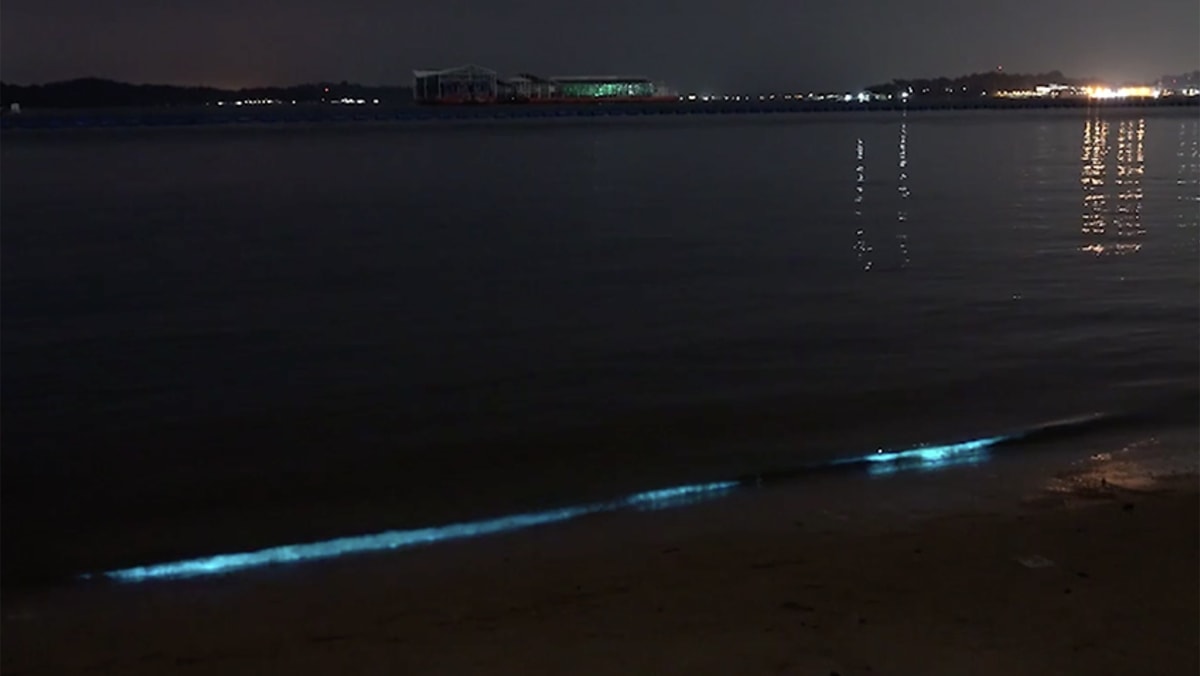SINGAPORE – While filming a short film on the Pasir Ris beach, a group of college students fell for something “magical”: incandescent neon blue waves crashing on the shore, known as “luminescent algae blooms”.
One of the bachelor students, Mr. Eric Teo, 24, who posted a video of the bioluminescent waves on Facebook on Tuesday (March 22), said: “It was really a sight to behold. look, you can see blue spots of glitter receding along with the waves, and they are shiny.
“It’s like glitter in the sea.”
HOW THEY CAME TO THE ‘BLUE’ WAVES
Mr. Teo and four other friends recorded a short film on Sunday as part of a submission for Nustudios’ Point and Shoot, a contest in which participants are given 55 hours to plan, shoot and edit a short film.
The group of first-year undergraduate students from Wee Kim Wee School of Communication and Information at Nanyang Technological University had arrived at the beach at three in the morning to shoot a scene for their film.
Mr Teo’s friends were the first to notice the neon blue waves, and Mr Teo, who was filming at the time, immediately put down his camera to take a closer look.
“I somehow knew about this phenomenon of bioluminescence. So I said, ‘Boys, I think we just came across something that is super rare in nature,'” Mr Teo recalled.
They were on the beach for an hour and the luminescent blooms are there most of the time they were there.
The “glitter” appears to be “dimmer” after Mr Teo returned Monday and Tuesday, he said.
WHAT THE WAVES ARE BLUE
Associate Professor Rebecca Case, a marine phytoplankton expert and principal investigator at the Singapore Center for Environmental Life Sciences Engineering, said the phenomenon is a form of chemical reaction.
Dinoflagellates, a type of phytoplankton or small marine plants, are microscopic marine algae that float with water currents. They produce an enzyme called luciferase, which reacts with oxygen to produce light.
Assoc Prof Case explains: “You can only find this light where there is oxygen (reacts with the algae). You see the blue light when a wave hits the sand, because in that case more oxygen is available for luciferase.
“When we swim or splash in water (or a wave crashes), seawater is mixed with oxygen. It is this increase in oxygen that causes luminescence.
That’s why it does not always shine.
Luminescent flowers are most commonly seen along the coast at night and Assoc Prof Case said she has seen them before Sydney in Australia – where she used to live – in Hawaii and Cape Cod in America and on Koh Tao in Thailand .
Assoc Prof Case, who moved here in August 2020 for work, said: “I am relatively new to Singapore and therefore I have not seen it in Singapore yet. I look forward to going out tomorrow (Thursday) night to try it out.
Dr Emily Curren, a research scientist at the Tropical Marine Science Institute of the National University of Singapore, said that under suitable climatic conditions such as rain, salinity and temperature, dinoflagellates rapidly reproduce and form algal blooms, leading to the “bioluminescent view”. .
This is because the cells are disturbed and compressed by waves.
Assoc Prof Case suspects that the recent monsoon season, which led to a long period of rain, caused the flowers. She also thinks that this phenomenon may be common in Singapore due to the high rainfall and warm weather here.
“Dinoflagellates like heat, and it’s always hot in Singapore,” she added.
Dr Curren noted that this is not the first sighting of bioluminescent phenomena and a similar one occurred in 2016 when it was an unknown dinoflagellate species that bloomed along the south coast of Singapore.
However, she said there is no cyclical occurrence of this phenomenon.
IS IT SAFE TO GET INTO THE ‘BLUE’ WAVES?
Although harmful algae blooms or “red spots” are caused by dinoflagellates, bioluminescent dinoflagellates are rarely – if at all – toxic and there is “no need to worry”, said Assoc Prof Case.
It is safe for people to go to the beach and swim in the water with these organisms, she said.
“Swimming in a luminescent flower is simply magical – watching the water as your body glides through the waves should be on everyone’s bucket list,” she added.
However, Dr Curren disagreed, saying that the public should “avoid direct contact if we do not understand the organisms and their characteristics”.
They could enjoy this natural phenomenon by looking and taking pictures instead.


Add Comment